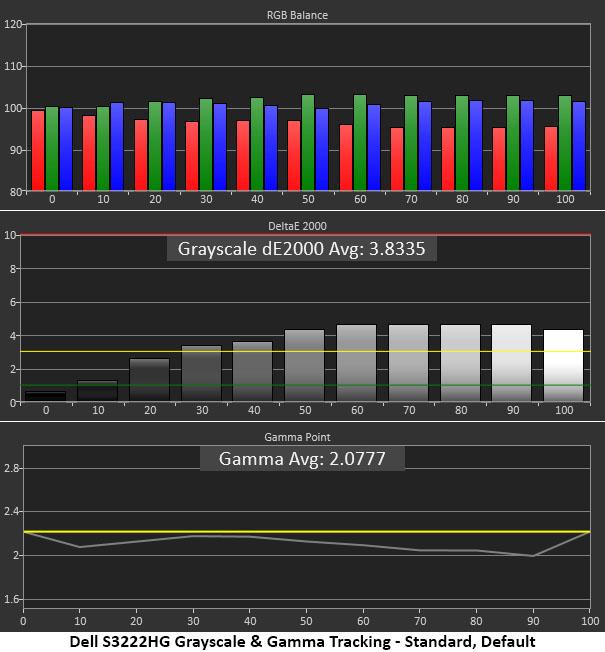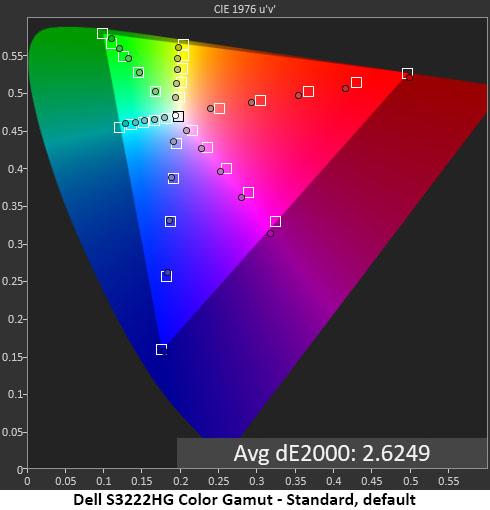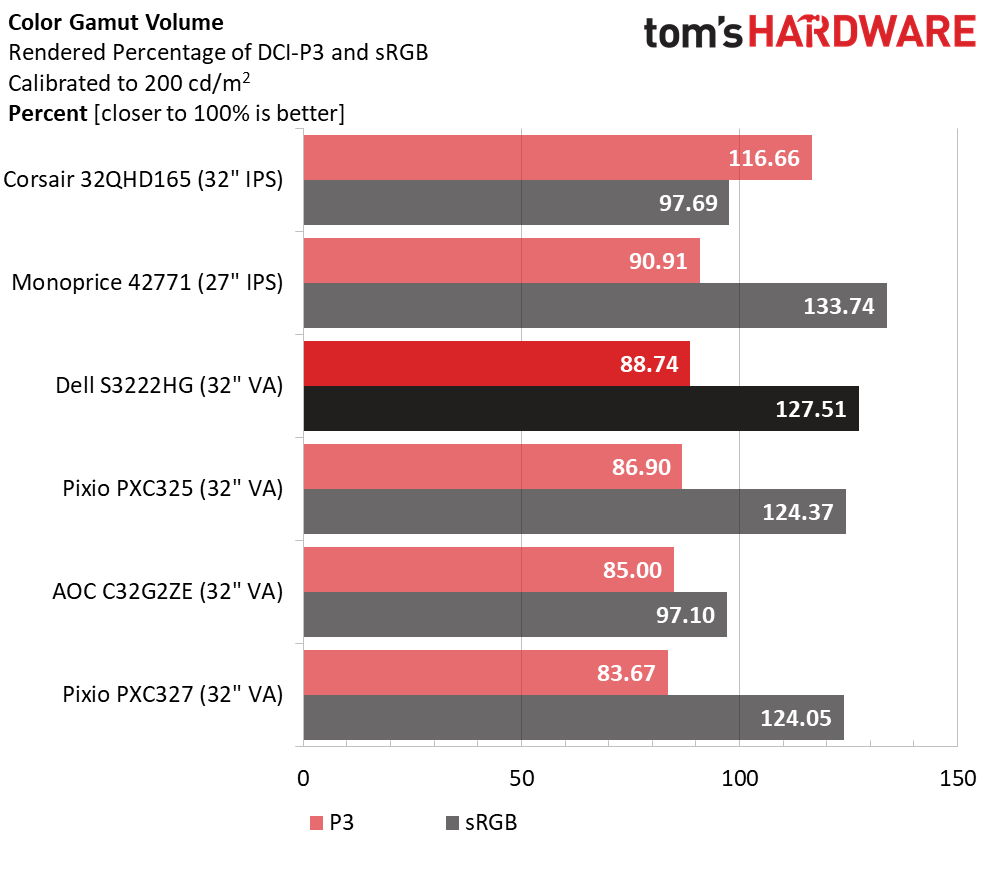Why you can trust Tom's Hardware
You can leave the S3222HG in its Standard picture mode and see a decent but cool-looking image. I found it a little flat but with solid contrast and plenty of brightness; some people will be satisfied to leave the monitor in its out-of-box state. But calibration, or the suggested settings, will make a visible improvement.
Grayscale and Gamma Tracking


Our grayscale and gamma tests use Calman calibration software from Portrait Displays. We describe our grayscale and gamma tests in detail here.
The first chart shows minor grayscale errors from 30 to 100% with a bluish-green tint. The error isn’t grievous since it can be corrected. Gamma tracking is also on the light side. 30 and 40% come close to the 2.2 line, but most values are a little too low (bright). While the visual impact is small, it would be nice if Dell added at least one darker gamma preset. VA panels usually benefit from gamma that’s either right on 2.2 or a little higher (darker).
Calibration doesn’t change gamma at all, but grayscale tracking is now exemplary. That improves color saturation slightly, which helps make the picture more vivid. These are small differences, but they are visible.
Comparisons




The S3222HG is right on the edge of the decision to calibrate or not. If you’re a nit-picker like me, the answer is “yes, it needs it.” For most users though, a 3.83dE default grayscale error isn’t a big deal. It’s enough to win the out-of-box contest in our group of budget monitors (minus the Corsair, which is premium-priced). This is very good performance.
The Dell drops to fifth place with calibration, but there’s no reason to complain about a 0.99dE score. That’s well below the threshold of visibility.
Though I complained about the S3222HG’s gamma errors, it sits mid-pack in this group. Very few monitors have perfect gamma tracking, and at this price point, it’s rare. A 0.18 range of values and 5.9% deviation is average for the category.
Get Tom's Hardware's best news and in-depth reviews, straight to your inbox.
Color Gamut Accuracy


Our color gamut and volume testing use Portrait Displays’ Calman software. For details on our color gamut testing and volume calculations, click here.
In the S3222HG’s Standard picture mode, you can see excellent coverage of the DCI-P3 gamut with only a little under-saturation in green. Red is also under in the inner targets, which takes a little warmth out of the image. The hue errors in yellow and magenta are slight but should be correctable with a grayscale adjustment.
With a few changes to the RGB gain & offset sliders, color tracking is improved. Though the change in error value is small, I could see a difference when viewing real-world content. Reds are more vibrant, and overall color saturation is better. A slightly darker gamma could make this even better, but that is a minor point. We’re looking at excellent performance for less than $270.
Comparisons


With an average gamut error of just 1.80dE, the S3222HG snags second-place in our budget panel comparison. Dell certainly hasn’t skimped on quality to achieve a low price. All the panels here deliver accurate color. The Monoprice has slightly visible issues but is still a satisfying screen to play on.
We don’t see a lot of FHD monitors with extended color, but it is becoming more common. The S3222HG has higher than average coverage of DCI-P3, which makes it a compelling choice in the sub-$300 segment. There is no sRGB mode, so you’ll need a software solution if a smaller gamut is required in your work. But for gaming and entertainment, the extra color volume helps increase perceived contrast and image quality.

Christian Eberle is a Contributing Editor for Tom's Hardware US. He's a veteran reviewer of A/V equipment, specializing in monitors. Christian began his obsession with tech when he built his first PC in 1991, a 286 running DOS 3.0 at a blazing 12MHz. In 2006, he undertook training from the Imaging Science Foundation in video calibration and testing and thus started a passion for precise imaging that persists to this day. He is also a professional musician with a degree from the New England Conservatory as a classical bassoonist which he used to good effect as a performer with the West Point Army Band from 1987 to 2013. He enjoys watching movies and listening to high-end audio in his custom-built home theater and can be seen riding trails near his home on a race-ready ICE VTX recumbent trike. Christian enjoys the endless summer in Florida where he lives with his wife and Chihuahua and plays with orchestras around the state.
-
Endymio Describing a 32" 1080p monitor as "relatively low" pixel density is quite an understatement. The most popular monitor segment of 27" @ 1440p is nearly twice the pixel density, and a smartphone may have more 6 times the density.Reply